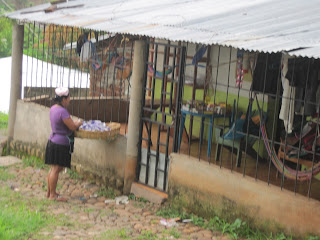At our first meeting in El Salvador, Cesar presented us with a fact sheet. To give you some background on El Salvador, I will share the facts in this blog along with a few pictures. My personal comments will be in parentheses:
1. El Salvador is the smallest and most densely populated country in Latin America, with a population of 6.6 million.
(This was evident especially on the streets of San Salvador. There was so much traffic and the buses were always packed with people.)
(I was very happy to not be driving in this but even wearing my motion sickness prevention bracelets, my body was not happy being a passenger in this kind of traffic!)
2. El Salvador received more than 3.5 billion in US dollars as family remittances in 2011.
3. The two main gangs in El Salvador are the MARA SALVATRUCHA and the MARA 18.
4. There are around 60,000 gang members in El Salvador.
5. In El Salvador businesses allocate an average of 11% of their monthly budget to pay for private security. (In front of almost every business you will see an armed guard, usually holding a rifle.)

(Guards outside the shopping market where we bought some souvenirs.)
6. More than 79,000 people were killed during the armed conflict that lasted 12 years. (Many innocent civilians were killed, including pregnant women and children. We spoke to a massacre survivor who shared his story with us. I will discuss it in a future entry but he was only 10 when it happened and listening to him describe the horror of that day was so difficult and emotional.)
7. The armed conflict officially began on January 10, 1981 and ended January 16, 1992, with the signing of the Peace Accords. (It was strange to hear about this war that was so recent. Most people living in El Salvador or who have left El Salvador have relatives that were tortured or murdered during the conflict.)
8. According to the United Nations Truth Commission Report, 85% of the human right violations during the civil war were committed by the Salvadoran government and the armed forces, 10% by the FMLN and 5% is unknown.
9. El Salvador is the second most deforested country in Latin America, after Haiti.
10. Per capita El Salvador is the second most violent country in the world. (This I knew before I left and it was kind of scary but I did not witness any violence while I was there. However, almost all of the houses and businesses had barbed wire around the roofs and bars on the windows-not something you see in the U. S. unless you are driving by a prison or something.)
(This is the outside of the house we stayed in-Casa Los Pinos. You can't really see barbed wire in this photo but you can see the bars on the windows. We were told not to answer the bell for the door. The staff would always stay up until everyone in the house arrived home for the night so they could make sure everyone got in. Police officers are parked in front of the house. This was a dead end street and the photo was taken from where the police station was located. )
11. During the seventies, eighties, and nineties fifteen catholic priests, Archbishop Romero, four US religious women and many other lay workers were assassinated in El Salvador.
12. There are around 28,000 police officers and around 30,000 private security officers in the country. (There was a police station right next to the house we stayed in. There was always at least one armed officer outside at all times. We have some pictures with them. They were very friendly.)
13. Around 75,000 Salvadoran women are working in the maquila industry; most of them are making the minimum monthly salary of $200.00 US Dollars.
14. Therapeutic abortion is illegal in El Salvador.
15. During the eighties and nineties, the Salvadoran government and army received around 1.5 million dollars a day as military aid from the U.S. government. (This definitely affected my view of our government and brought many questions to mind.)
16. El Salvador has the third highest reported HIV/AIDS cases in Central America, after Honduras and Guatemala.
17. According to the Salvadoran Health Ministry, there are 24,000 reported cases of HIV/AIDS in the country. However, ONUSIDA, after a research conducted several years ago, concluded that more than 48,0000 people were HIV positive.
18. The two main political parties in the country are Alianza Republicana Nacionalista (ARENA) and the Frente Farabundo Marti para la Liberacion Nacional (FMLN). (We met with representatives from both parties.)
19. Close to 3 million Salvadorans live outside the country, with the highest concentration in Los Angeles, California.
20. Between 500 and 700 Salvadorans cross the El Salvador and Guatemalan border every day, the majority of them heading to the U. S.
21. Between 10 and 12 people are killed by violence every day in El Salvador.
22. El Salvador was the first country in Central America to ratify Central American Free Trade Agreement (CAFTA).
23. El Salvador was the third Latin American country to withdraw troops from Iraq; December 2008.
24. Mauricio Funes from the FMLN political party won the presidential elections on March 15 and took office on June 1, 2009.
25. There were approximately 4,300 people killed by violence in El Salvador in 2011.
26. Mauricio Funes, the current Salvadoran president is one of the most popular in Latin America with 60% approval. (I think this may be an old statistic as we were told by many that they are afraid the FMLN will not win the election in 2014.)
27. The Salvadoran economy was dollarized in 2001.
28. Remittances decreased 8% and the Salvadoran economy declined 3% in 2011.






























